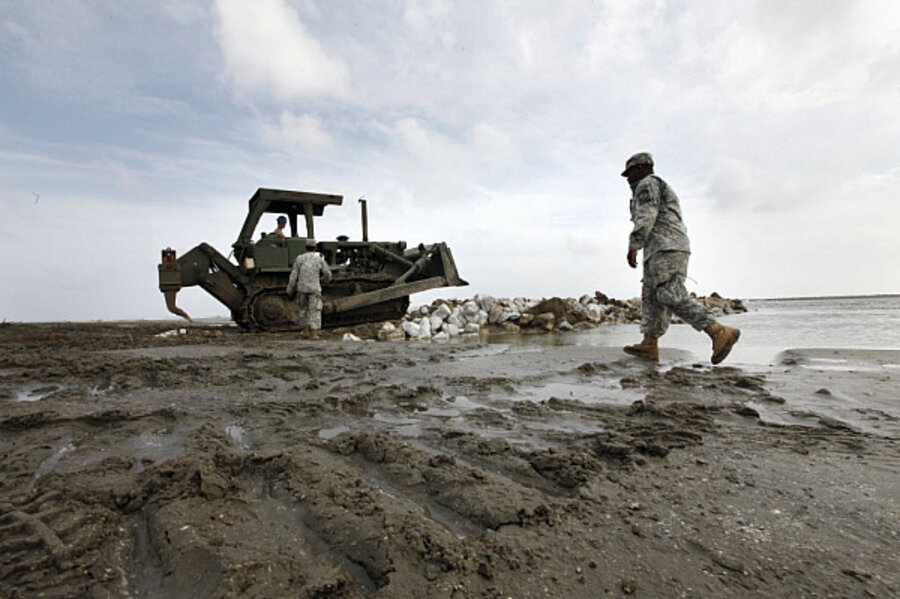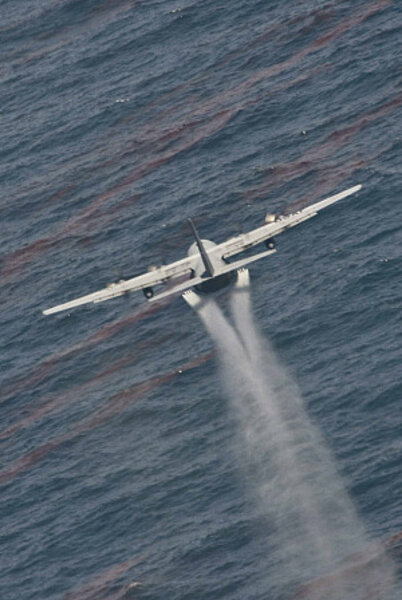In Gulf oil spill, how helpful – or damaging – are dispersants?
Loading...
Two dispersants BP has been using to break up the oil spewing from an undersea wellhead in the Gulf of Mexico carry the federal stamp of approval. But they are not rated as effective or as safe for marine life as at least 12 other government-approved dispersants on the market.
Environmental groups are asking why this is the case, and they suggest BP may reduce damage to coastal habitats by breaking up the oil before it hits shore – but at the expense of the marine ecosystem further out in the Gulf.
In the four weeks since the Deepwater Horizon rig capsized after an explosion, BP has released 436,000 gallons of the two dispersants, Corexit EC9500A and Corexit EC9527A, the company says. Dispersants break up the escaped oil into molecular bits before it reaches shore.
IN PICTURES: Louisiana oil spill
The Environmental Protection Agency (EPA) has pre-approved both for such emergencies. The effectiveness of Corexit EC9500A is rated as 55 percent, and the effectiveness of Corexit EC9527A is rated as 63 percent, according to the EPA. That ranks them behind 12 other dispersants (out of 18) that the agency has determined do a better job dispersing oil while protecting marine life.
As for toxicity, the EPA rates both products as either comparable in toxicity or 10 to 20 times more toxic than the 12 others on the list. This week, BP chief executive Tony Hayward told The Guardian newspaper that the amount was “tiny in relation to the total water volume” in the Gulf.
Reliance on dispersants, especially in response to a disaster on par with the 1989 Exxon Valdez oil spill in Alaska, is understandable, say environmental groups. What they don’t understand is why marine ecosystems are being sacrificed to save coastal habitats, a trade-off that wouldn’t be an issue if less toxic solutions were stockpiled.
Not enough is known about how the Corexit products will affect marine life, says Richard Charter, senior policy adviser for marine programs with Defenders of Wildlife, an advocacy organization in Washington. Not only is the size of the spill unique, but the Gulf environment presents conditions that EPA testing would not necessarily replicate in a lab.
“You now have a giant chemistry experiment being done in the Gulf of Mexico,” Mr. Charter says.
Dispersants in general are also unpredictable in this situation because it is uncertain where the molecules will travel and eventually settle, due to heavy tidal conditions and tropical storms, and what byproducts will form as a result.
“What effect that will have we don’t know,” says Judy Haner, marine program director for the Alabama chapter of the Nature Conservancy.
There is no “direct way to know exactly which [habitats]” will be affected by the dispersants, said Jane Lubchenco, undersecretary of commerce for oceans and atmosphere and head of the National Oceanic and Atmospheric Administration, in a conference call with reporters Wednesday. “Anything that we say at this point is speculation,” Dr. Lubchenco said, adding that monitoring will continue.
EPA officials say the agency only has the power to pre-approve dispersant products and has no say about which ones companies choose to stockpile as part of their contingency plan. BP chose to use Corexit because it was available the week of the explosion, says EPA Administrator Lisa Jackson. EPA is allowing BP to use the product only on the water's surface, she says. The company is seeking approval to use it underwater, Ms. Jackson adds. So far, two tests proved inconclusive in determining its effectiveness under water, and results of a third test are not yet known.
“Dispersants are not the silver bullet” in containing the oil, Jackson says.
Corexit is a brand of dispersant manufactured by Nalco Co., located in Naperville, Ill. Corexit EC9527A has a better environmental rating than Corexit EC9500A because it has been on the market longer, says company spokesman Charlie Pajor in a phone interview. Nalco is increasing production of both, but Mr. Pajor says the scope of the disaster will give the company better insight into the product’s future development, which will include “looking at ways to improve the environmental profile and effectiveness of the product.”
Critics have said the major oil companies stockpile Corexit, despite its relatively poor toxicity rating, because of their cozy relationship with Nalco. Nalco’s executives include a former BP board member and a former Exxon executive. Critics cited by Greenwire, an online news organization that covers environmental and energy issues, say the company’s board of directors is stacked with oil industry insiders.
Pajor says the company is being misrepresented and, contrary to news reports, was never owned by Exxon. Nalco and Exxon Chemical formed a joint venture called Nalco Exxon Energy Chemicals in 1994. Following a takeover by a parent company in 2001, Exxon’s interest was bought out and the two companies no longer have a relationship, Pajor says.
IN PICTURES: Louisiana oil spill
Related:
As Obama scolds BP, debate brews over how much oil is leaking






